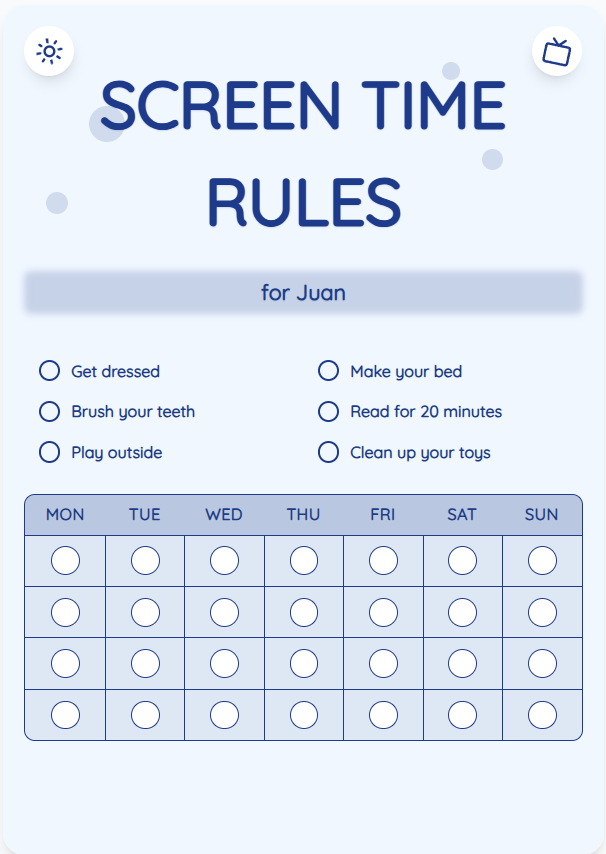Exploring the Meaning of Screen Time Limits for Parents
As a parent, understanding the significance of screen time limits is crucial in promoting healthy child development and family balance. In this comprehensive guide, we will delve into the definition, benefits, and practical tips for setting screen time limits for children aged 2-12.
See What Your Screen Time Chart Will Look Like
Here's an example of a beautiful, customizable screen time rules chart you can create for your family

What Does Screen Time Limit Mean?
Screen time limit refers to the recommended duration that children should spend on electronic devices such as smartphones, tablets, computers, and TVs. Setting limits helps prevent excessive screen use, which can lead to various negative impacts on children's physical health, mental well-being, and social skills. By establishing boundaries around screen time, parents can encourage healthier habits and promote a balanced lifestyle for their children.
Benefits of Imposing Screen Time Limits
Limiting screen time offers numerous benefits for children. It promotes better sleep patterns, reduces the risk of obesity, enhances cognitive development, fosters creativity, and improves social interactions. By regulating screen time, parents can create opportunities for their children to engage in physical activities, explore hobbies, and spend quality time with family and friends.
Put These Tips Into Action
Create a custom chart to implement these strategies with your child
Practical Tips for Managing Screen Time
1. Establish clear rules: Set specific guidelines on when and how long children can use screens. 2. Use screen time charts: Utilize visual aids like screen time charts to track and limit device usage. 3. Encourage alternative activities: Promote outdoor play, reading, arts and crafts as alternatives to screen time. 4. Be a role model: Demonstrate healthy screen habits by limiting your own device use in front of your children.
Practical Tips for Success
- Set specific guidelines for screen time usage
- Use screen time charts to visually represent limits
- Promote alternative activities to screen time
- Lead by example by practicing healthy screen habits
Frequently Asked Questions
How can I determine the appropriate screen time limits for my child?
The American Academy of Pediatrics recommends no more than 1 hour of high-quality screen time per day for children aged 2-5. For older children, it's advisable to set consistent limits based on their age and individual needs.
What are the consequences of excessive screen time?
Excessive screen time has been linked to various issues such as obesity, sleep disturbances, poor academic performance, behavioral problems, and reduced social skills. Setting limits can help mitigate these risks.
How can screen time charts help in managing device usage?
Screen time charts provide a visual representation of allocated screen time and help children understand and adhere to set limits. They serve as a tangible tool for parents to monitor and regulate screen time effectively.
By understanding the meaning of screen time limits and implementing practical strategies like using screen time charts, parents can foster a healthy balance between digital engagement and other activities in their children's lives. Visit ScreenTimeRules.com to access customizable screen time charts and start managing screen time effectively today.
Ready to Transform Your Family's Screen Time?
Join thousands of parents who have successfully managed screen time with our customizable charts.
